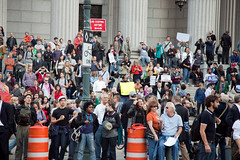
Koch Industries won contracts with bribes and sold millions of dollars worth of petrochemical equipment to Iran, according to a new expose by Asjylyn Loder and David Evans of Bloomberg.
The politicking of oil baron brothers Charles and David has made the Koch name (pronounced “Coke”) a household word. Koch Industries has spent over $50 million on federal lobbying since 2006. Koch charities have spent millions more on infrastructure for the conservative movement. Koch-funded academies have trained a generation of Tea Party activists.
Loder and Evans reveal that Koch Industries bribed company officials overseas to secure contracts with their firms. The illegal payments were made through the French-owned subsidiary, Koch-Glistch, but when the nefarious activity came to light in French labor courts, whistleblowers convinced the courts that the wrongdoing reached far up the chain of command. Koch Industries also used foreign subsidiaries to circumvent the U.S. ban on trading with Iran, an officially recognized state sponsor of terrorism.
Those are just the new allegations of wrongdoing by Koch Industries. Bloomberg also summarizes a littany of misdeeds that the company has already been caught and fined for or settled with victims over the past several decades. The story documents how regulations and torts have cost Koch Industries millions of dollars.
Loder and Evans flesh out a rapsheet decades in the making. Offenses include leaking 91 metric tons of the carcinogen benzene into the air and lying about it, bilking Native Americans out of oil royalties, negligently allowing a pipeline to corrode until leaking gas burned two teenagers to death, and much more.
Loder and Evans write:
For six decades around the world, Koch Industries has blazed a path to riches – in part, by making illicit payments to win contracts, trading with a terrorist state, fixing prices, neglecting safety and ignoring environmental regulations. At the same time, Charles and David Koch have promoted a form of government that interferes less with company actions.
This story is a courageous and damning indictment of Koch Industries. What’s more, the authors explicitly link the Koch Brothers’ philosophy of unfettered capitalism and their unethical business practices.
There’s no point in speculating about whether the Koch’s investment in the anti-government, anti-regulation, anti-tort activism is fuelled by greed or sincere conviction. From a citizen’s perspective, it makes no difference whether they are driven by pure profit, or whether they sincerely believe that their property entitles them to i) swindle other companies by bribing their employees to make contracts that never would have survived in the free market, ii) to trade with an enemy of the United States, iii) to pollute our environment, and iv) to steal natural resources from their rightful owners. The only question is whether we, the people, think they’re so entitled, and if not, what we are going to do about it?
[Photo credit: Sue Peacock, Creative Commons.]






 In about an hour, several major unions will join the Occupy Wall Street protesters for a mass rally and march in New York City and Clear it with Sidney will be there. Here’s a map of the route. Stay tuned for a report this evening.
In about an hour, several major unions will join the Occupy Wall Street protesters for a mass rally and march in New York City and Clear it with Sidney will be there. Here’s a map of the route. Stay tuned for a report this evening.

